A Master of Folk Culture: Jhuang Bi-fei's Handmade Fishing Nets/莊碧飛 常民文化的編織之美
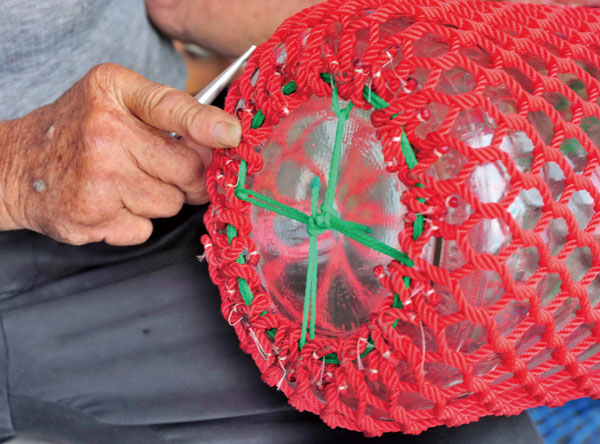 A Master of Folk Culture:
A Master of Folk Culture:
Jhuang Bi-fei's Handmade Fishing Nets
◎English translation: Peng Hsin-yi
◎Photos by Pao Chung-hui
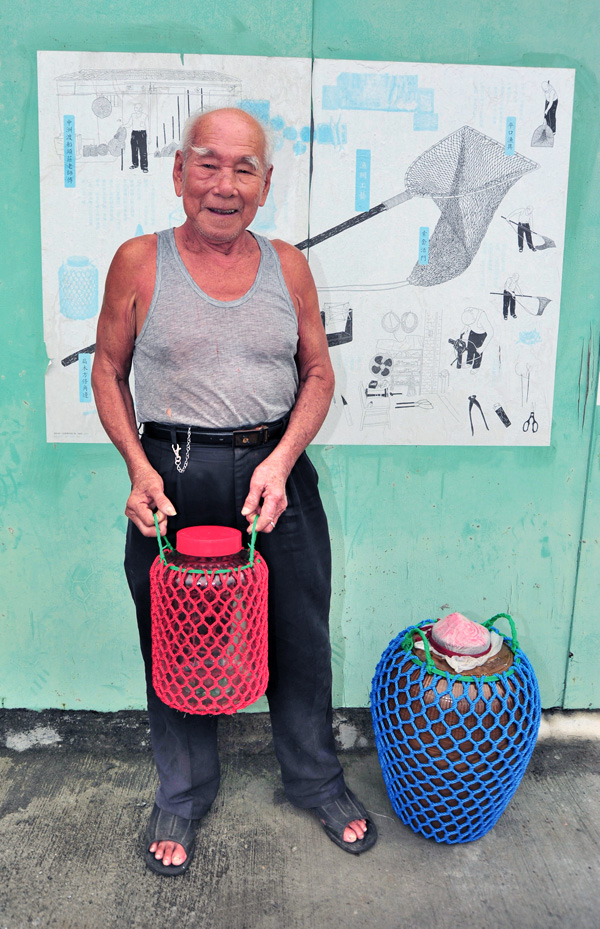 Cijin is one of Kaohsiung's most popular tourist attractions. Its charming ocean scenery and fresh, delicious seafood never fail to satisfy visitors. But there is another, quieter side of Cijin worth exploring. There are artisans on the island who still make fishing nets and boat propellers by hand. When they work, no detail is neglected. This is where one can see how ocean traditions have taken root in Taiwan's Maritime Capital.
Cijin is one of Kaohsiung's most popular tourist attractions. Its charming ocean scenery and fresh, delicious seafood never fail to satisfy visitors. But there is another, quieter side of Cijin worth exploring. There are artisans on the island who still make fishing nets and boat propellers by hand. When they work, no detail is neglected. This is where one can see how ocean traditions have taken root in Taiwan's Maritime Capital.
Mr. Jhuang Bi-fei, a fishing net artisan, was born and raised in Cijin. Now 82, he has lived and worked all his life in Cijin. He was a seaman like his father, and when he turned 58, he retired from the seas. However, he did not retire the skill of making fishing nets he had acquired during his years working on boats. After "retirement" he started making nets for carrying glass jars. The steps by his front door became his new workplace, and in his practiced hands a roll of nylon twine became a grid, and then a net. He sometimes makes nets to order, but often makes them just to pass time. Across the street, just a few steps away from his house, is Jhongjhou Fishing Harbor. On the dock, fishermen patch up nets torn during a recent voyage. It is a precious moment in a fishing town, tranquility utterly undisturbed.
Mr. Jhuang says these days no one wants to learn how to make nets. He explains that fifty years ago, net-making was considered a woman's job, but since he worked on a fishing boat, he learned to do it so a voyage would not be cut short by a broken net. He started to experiment with different ways in order to improve his skills, and finally figured out a way to produce the most effective net. Now retired from the open sea, the years he spent perfecting his net-making skills are not wasted. He started by making smaller nets which have various practical everyday uses. Sometimes he accepts commissions from his friends in the fishing industry, from big pieces like a boat's bumper to small items like a hand-held net. Whether he works with glass fiber or simple nylon strands, he always starts with a design that suits the user's needs, and makes a product that is practical, durable and attractive. No detail is too small; he even considers how much future maintenance will be required. He works at a steady rhythm, and the product is delivered once he is satisfied with it.

As Mr. Jhuang makes a net for carrying a glass jar, he says the idea came to him randomly one day. He simply thought the jar would be safer if carried in a net, and this kind of item has become his signature work. One of his friends saw this kind of net and asked Mr. Jhuang to make another, and then he started to receive orders left and right. To date, he has made about fifty. Even with something as small as a net for holding a jar, he gives his best. With the enthusiasm of a true artist, he demonstrates how to use single knots and double knots in intervals to crochet the twine into a net. He has to calculate carefully to ensure the space between each line is even, so the net is pleasing to the eyes. The most challenging part is tying up the bottom. Each knot has to be tied with care and in the correct order. Even though what Mr. Jhuang makes these days are insignificant household items, he never cuts corners. With pride, he says his nets are far superior to machine-made equivalents.
Looking at Mr. Jhuang's work, one can not help but feeling a bit sad, knowing that this skill, and the beauty of meticulously handmade crafts, will be no more when he is gone. Right now, in the presence of a living, breathing folk-arts museum, we can still have our breaths taken away by the unparalleled beauty of simple things.
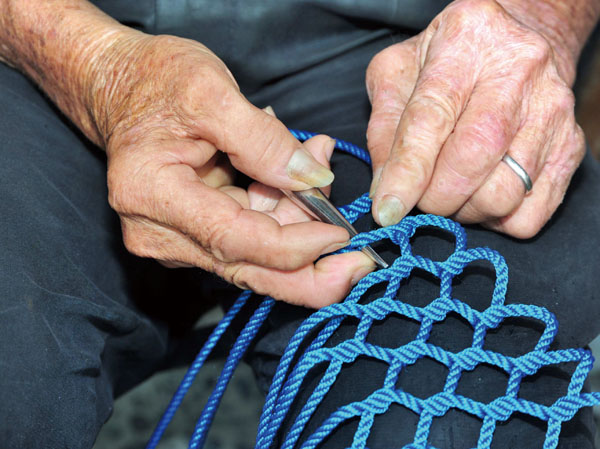 莊碧飛
莊碧飛
常民文化的編織之美
◎文/侯雅婷
◎攝影/鮑忠暉
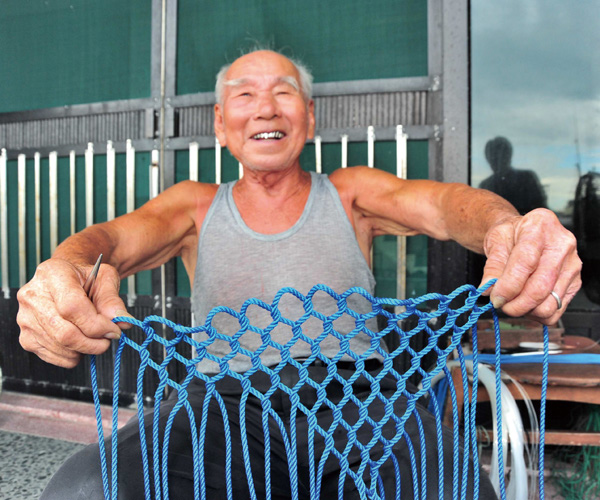 旗津是著名觀光勝地,以迷人的海色風光和生猛海味料理名聞遐邇;當地應運而生的海洋產業靜靜地體現深刻動人的在地文化,比如編織魚網和手製船用螺旋槳等,細膩的工藝,讓人窺見屬於海洋傳統的文化魅力。
旗津是著名觀光勝地,以迷人的海色風光和生猛海味料理名聞遐邇;當地應運而生的海洋產業靜靜地體現深刻動人的在地文化,比如編織魚網和手製船用螺旋槳等,細膩的工藝,讓人窺見屬於海洋傳統的文化魅力。
82歲的莊碧飛是旗津織漁網的職人,自幼在旗津長大,承襲父親討海的職業。58歲那年,他卸下跑船生涯,伴隨他退休後的是半輩子討海生涯練就編織漁網的功力。他在自家門前編著包覆玻璃甕的網子,編織手法俐落靈活,只消一會兒功夫,一格格的編織圖成形,有時應付客人訂單,更多時候是打發時間;幾步之遙,對街望去是泊靠船隻的中洲漁港,熟識的漁民在對面修補著上回出海勾破的漁網,與莊碧飛編織網子正相映成趣,造就一幅閒適的漁村風光。
莊碧飛說編漁網這活現在沒人要做囉,他談起50年前,編織魚網的工作多由婦人擔任,當時他跑船為生,為了提升漁獲量,他摸索著編織技術,每回出海,總反覆打量著漁網是否仍可再改進,自行編織出使用效能最佳的漁網,在當時奠定深厚編織功力。他現在將編織漁網的功夫,運用到補漁的用具乃至生活器皿,偶有熟識漁民委託他製作道具,大從防漁船碰撞墊,小至一根撈魚的網子,他總悉心為使用者設想,致力提升產品實用、耐用度和美觀,不管是玻璃絲還是尼龍繩編織的網子,充滿規律和韻律的美感,並將日後維修問題也納入考量。
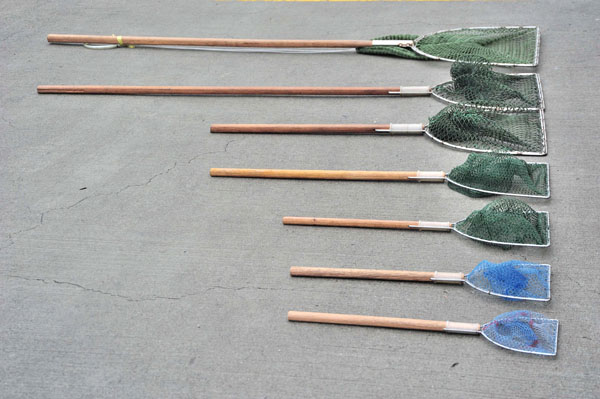 談起手中編織包覆玻璃甕用的網子,莊碧飛說當初怕玻璃甕破裂,興起編網子保護甕仔的想法。若說這只尼龍繩編織的精美網子是莊碧飛畢生功力集大成,可是一點也不為過,他的朋友偶然看見這只網子,央求他代為編製,意外開起了玻璃甕網子的通路,至今約莫編製了50個。他熱心的解說著如何運用單結和雙結於尼龍繩編織出包裹玻璃甕的網子,透過計算著固定的間隔,使每格網子呈現整齊美感,底部的收尾更是考驗編織功力,每個環節都紮紮實實、井然有序的捆綁起。儘管莊碧飛製作的是常民生活中的日常小物,但從不馬虎,他頗自豪的說,他製作的網子是機器所不能比擬的。
談起手中編織包覆玻璃甕用的網子,莊碧飛說當初怕玻璃甕破裂,興起編網子保護甕仔的想法。若說這只尼龍繩編織的精美網子是莊碧飛畢生功力集大成,可是一點也不為過,他的朋友偶然看見這只網子,央求他代為編製,意外開起了玻璃甕網子的通路,至今約莫編製了50個。他熱心的解說著如何運用單結和雙結於尼龍繩編織出包裹玻璃甕的網子,透過計算著固定的間隔,使每格網子呈現整齊美感,底部的收尾更是考驗編織功力,每個環節都紮紮實實、井然有序的捆綁起。儘管莊碧飛製作的是常民生活中的日常小物,但從不馬虎,他頗自豪的說,他製作的網子是機器所不能比擬的。
端視莊碧飛的作品,其工藝技術、做工嚴謹和手作美感,讓人彷彿置身於庶民博物館般,儘管這項技藝即將失傳,但無比精彩的作品,總讓人讚嘆不已。